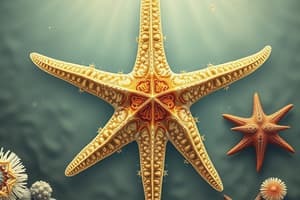Podcast
Questions and Answers
What type of symmetry does your starfish have?
What type of symmetry does your starfish have?
- Radial Symmetry (correct)
- Bilateral Symmetry
- Asymmetrical
- None of the above
What is the upper surface of the starfish called?
What is the upper surface of the starfish called?
Aboral Surface
What is the lower surface of the starfish called?
What is the lower surface of the starfish called?
Oral Surface
What part of the tube foot creates suction to open clams whenever the starfish feeds?
What part of the tube foot creates suction to open clams whenever the starfish feeds?
What type of skeleton does the starfish have?
What type of skeleton does the starfish have?
What is the function of the pyloric caeca?
What is the function of the pyloric caeca?
Where is the stomach of a starfish located?
Where is the stomach of a starfish located?
What can the starfish do with its stomach when feeding on clams and oysters?
What can the starfish do with its stomach when feeding on clams and oysters?
What is the Kingdom of the starfish?
What is the Kingdom of the starfish?
What is the Phylum of the starfish?
What is the Phylum of the starfish?
What is the Class of the starfish?
What is the Class of the starfish?
Flashcards are hidden until you start studying
Study Notes
Starfish Anatomy and Physiology
- Asteroideas refers to true sea stars and sun stars.
- Starfish exhibit radial symmetry, allowing them to have multiple similar parts arranged around a central axis.
- The upper surface of the starfish is called the aboral surface, while the lower surface is known as the oral surface.
Structural Features
- The mouth is located on the oral surface.
- The madreporite is an important structure found on the aboral surface, playing a key role in the water vascular system.
- Suckers are present on the oral surface, enabling the starfish to adhere to surfaces and prey.
- Oral spines are located on the aboral surface, aiding in defense and feeding.
- Eyespots can be found on the oral surface, allowing the starfish to sense light.
Water Vascular System
- Water travels around a central ring and extends into the arms (legs) of the starfish through the water vascular system.
- The ampulla part of the tube foot creates suction to help starfish open clams when feeding.
Reproductive System
- Gonads may appear larger due to differences in reproductive organs between male and female starfish.
Skeletal Structure
- Starfish possess an endoskeleton, composed of bony plates called ossicles.
- The pyloric caeca constitutes finger-like projections located in the stomach, serving a digestive function.
- The stomach is centralized within the starfish structure, specifically in the central ring circle.
Feeding Mechanism
- Starfish can evert their stomach through the mouth to ingest prey, such as clams and oysters.
Biological Classification
- Starfish belong to the Kingdom Animalia.
- They are classified under the Phylum Echinodermata.
- The Class of starfish is Asteroideas.
Studying That Suits You
Use AI to generate personalized quizzes and flashcards to suit your learning preferences.




